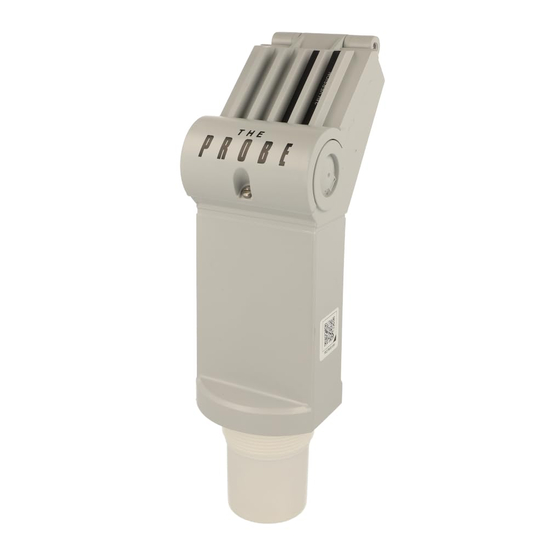
Sommaire des Matières pour Siemens Milltronics 7ML1201-1FE00
- Page 14 Page 12 The Probe – INSTRUCTION MANUAL 7ML19981GD61...
- Page 26 Seite 12 The Probe – BETRIEBSANLEITUNG 7ML19981GD61...
- Page 38 Página 12 The Probe – MANUAL DE INSTRUCCIONES 7ML19981GD61...
- Page 39 Introduction Note : Le Probe doit être utilisé suivant les instructions fournies dans ce manuel. L’unité de mesure de niveau Probe intègre l’électronique et le capteur dans un seul et unique boîtier. Cette unité est destinée à la mesure de liquides, dans toutes cuves ou réservoirs fermées. Le capteur est fabriqué...
-
Page 40: Raccord Fileté
Raccord fileté couvercle à charnière 7 mm L’unité est disponible en trois versions de 84 mm (0.3") (3.3") max. filetage : 2" NPT, 2" BSP ou PF2. 117 mm (4.6F") Note : Afin d’éviter d’endommager Le Probe pré-perçage lors de l’installation, vérifier que le filetage électronique 279 mm (11") -
Page 41: Fonctionnement
Interconnexions Notes : • L’installation doit être effectuée par un personnel qualifié, en accord avec les dispositions locales en vigueur. • Il peut être nécessaire de séparer les câbles et conduits pour respecter les prescriptions particulières, consignes de câblage et normes électriques. A. -
Page 42: Etalonnage : Méthode De Référence
Etalonnage L’étalonnage de la sortie analogique peut être réalisé de telle sorte qu’elle soit proportionnelle ou inversement proportionnelle au niveau mesuré. Note : L’étalonnage des niveaux 4 et 20 mA n’est pas soumis à un ordre particulier. proportionnelle inversement proportionnelle niveau haut = 20mA niveau haut = 4 mA niveau bas = 4 mA... -
Page 43: Etalonnage, Méthode Pas À Pas
Réglages Plusieurs réglages sont possibles pour optimiser le fonctionnement de l’unité Probe. • Presser les touches "4" et "20" jusqu’à obtenir le réglage souhaité. La valeur programmée est automatiquement affichée. • Pendant ce temps, la valeur peut être modifiée en pressant la touche "4" ou "20". Une fois la valeur visualisée ou modifiée, l’unité... -
Page 44: Zone Morte
Zone Morte La zone morte est utilisée pour masquer la zone sous le Le Probe capteur où les échos parasites sont à des niveaux zone morte pouvant interférer avec le traitement de l’écho vrai. La zone morte est mesurée vers l’extérieur à partir de la face du capteur. -
Page 45: Sécurité-Défaut
• Pour modifier le temps de réponse, visualiser `SP'. • Presser la touche "20" pour visualiser les options (1-2-3). Presser la touche "4" pour visualiser les options (3-2-1). • Une fois l’option souhaitée affichée, cesser de presser la touche. L’afficheur revient automatiquement en mode Run (6 secondes). -
Page 46: Temporisation Sécurité-Défaut
• Pour modifier la valeur par défaut, visualiser `FLS'. • Presser la touche "20" pour visualiser les options (1-2-3). Presser la touche "4" pour revenir aux options (3-2-1). • Cesser de presser la touche dès que l’option souhaitée est affichée. L’affichage revient automatiquement en mode Run (6 secondes). -
Page 47: Dépistage Des Défauts
Supplément Charge / tension d’alimentation Dépistage des défauts L’écho reçu n’est pas fiable. Le Probe attend de recevoir un écho valide avant de rafraîchir la mesure. Les causes probables sont : • Matériau ou cible en contact avec la face émettrice du capteur •... -
Page 48: Caractéristiques Techniques
Caractéristiques Techniques Alimentation : • 18 à 30 V cc, 0.2 A maximum Caractéristiques environnementales : • montage : en intérieur / extérieur • altitude : 2000 m maximum • température continue : - 40 à +60°C (-40 à +140°F) ambiante: -20°C (-5°F) pour montage métallique •... - Page 49 Construction : • monobloc, incluant le capteur et l’électronique • corps du capteur : matériau : PVDF ou ETFE montage : filetage : 2”NPT, 2" BSP PF2 bride : adaptateur bride, 3" ANSI, DIN 65PN10 et JIS 10K3B sanitaire : col sanitaire 4" approuvé par la FDA avec anneau d’étanchéité...
- Page 50 Page 12 Le Probe – MANUEL D’INSTRUCTIONS 7ML19981GD61...














